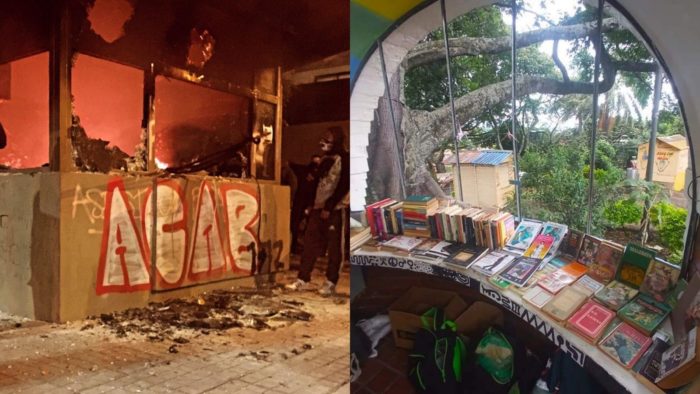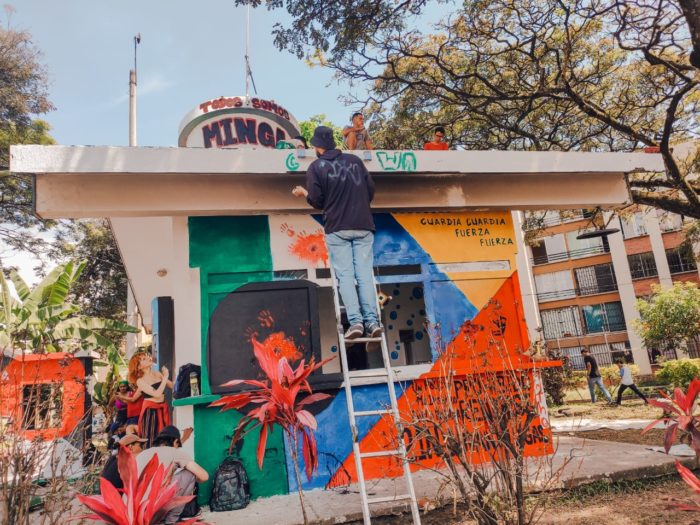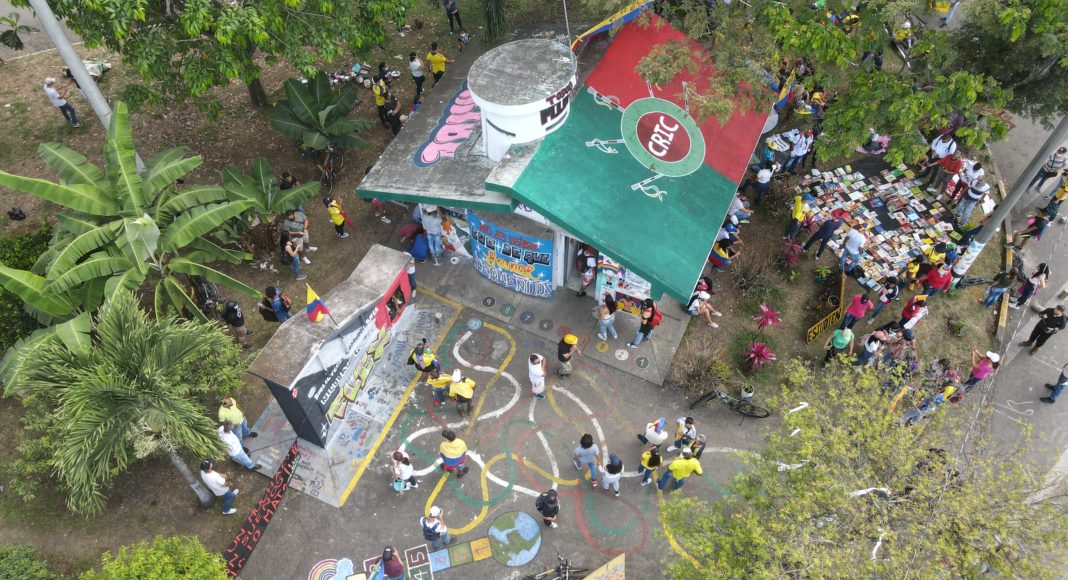In summer 2021, a three-month national strike against the right-wing government of Colombian president Iván Duque proved a remarkable time for movement-building and social change. Although protests began in reaction to a proposed tax reform, one of the main demands from protestors, aside from commitment to the peace agreement, was police reform. Police stations across the country were ‘taken’ by protestors and repurposed. In the city of Cali, the epicentre of the protests, four police stations were occupied by grassroots groups and turned into community libraries.
Small police stations in Colombia are known as CAI (for their acronym meaning centres of quick attention). They are found in every neighbourhood around the country. Although they were initially intended to bring the police closer to the communities they protect, they have become a symbol of oppression and many Colombians denounced violence and torture by officers within these spaces during the protests.
In response from protestors, CAI police stations across the country were vandalized and occupied. In the City of Cali, worst affected by violence related to the protests, four of these attacked police stations were occupied by grassroots groups who turned them into community libraries.

‘The national police service is a very flawed institution. We don’t think that the police are there to protect us; on the contrary, sometimes they are there to inflict violence and they ignore the needs of the community,’ says Jonathan Valencia, a cultural coordinator for an independent bookshop in Cali and co-founder of the community library La Dignidad, the first community library to be established in an occupied police station.
La Dignidad library opened as a cultural hub just two days after it was targeted by protestors. Members of the community cleaned and painted the space, street artists covered the walls with murals, and more than 200 books were donated. Soon after, organizers programmed a cultural agenda for the community library, which included poetry readings, theatre workshops, storytelling, and drawing classes for children. A space that once symbolized state oppression was co-opted for the community, by the community.
The Nicolás Guerrero library was the second to open, named after a young street artist who was killed by ESMAD riot police in Cali on 3 May at a vigil in honour of victims of the protests. That night, amidst lit candles, ESMAD officers arrived with tanks and launched tear gas at the public. Some protestors responded by throwing stones and the peaceful vigil became chaotic. Within the chaos, Nicolás Guerrero was shot. An Instagram livestream provides strong evidence that the bullet that killed him was fired by ESMAD.
Guerrero’s death sparked outrage and in the chaos that ensued, the local police station was vandalized. ‘The police station was destroyed by angry protestors. For 10 days it lay empty and during that time it was looted. They ripped out the electrical system and the pipes, rubbish was thrown inside, we even found human faeces,’ says Edier Betancourt, a schoolteacher and one of the founders of the Nicolás Guerrero library in Cali.
A group of neighbours got together and decided to reclaim the abandoned police station for the community. ‘We made an open call for anyone who wanted to help. We cleaned the police station and the young people who answered the call came to paint the walls, people donated books, the neighbour who knows about electricity installed the energy, a neighbour who is a plumber reinstalled the water, a group of neighbours created a vegetable plot,’ Betancourt describes.
The library brought the community together, both in its construction and use. People who never thought they could sit in a park to read a book without being considered suspicious suddenly had a place of their own. ‘For many of us in the community, this police station didn’t offer any security. On the contrary, it reflected resentment and repression. Rather than protect us, we felt that the police station was there to exercise control over us,’ says Laura Guerrero, Nicolás’ mother. Through ascribing new meaning to a site that once represented violence and oppression, grassroots groups sent a clear message: they wanted to see more cultural spaces, better access to education, and a peaceful environment in which to live. It was a transformative movement during nightmarish months in Colombia.

The third community library to be established in a police station was the Marcelo Ágredo Community Library in Puerto Resistencia, a marginalized zone in Cali where cultural activities and public libraries are scarce. The library was named in honour of the first fatal victim of the protests, 17-year-old Marcelo Ágredo, who was shot in the head by a police officer on a residential road of Cali after Ágredo kicked him off his motorcycle. The moment was caught on camera and shared widely on social media.
This community library was the hardest to transform, as the police station had been burned by protestors. However, in a way its conversion into a community space had already begun, given that Puerto Resistencia was a central point in the protests, and the burned police station was used as a bunker by protesters.
Two young women led the construction of the Marcelo Ágredo Community Library library, by convincing the ‘Primera Línea’ protestors to allow them to turn the space into a community hub. [The Primera Línea were the ‘first line’ of defence against the military police crackdown, consisting in multiple blockades of protestors wearing armour improvised from clothes, lamp posts, speed bumps and metal drums, pushing back against the armed forces.]
Photos shared on social media of the library’s beginnings depicted a protestor sitting in a ruined room reading a book. The image spoke both of desire and grief. From here, the space transformed into a community hub thanks to a remarkable amount of work from the community. The walls were painted in different colours and street art began to crop up. In the entry, artists wrote the names of those who were killed or disappeared since the first day of protest. Following in the footsteps of the other two community libraries, they created a cultural agenda that attracted young people, families with children, and members of the wider community.
Social transformation
By mid-August 2021, when the national strike came to an end, the police began to reclaim these communal spaces and one by one the community libraries were closed. Though they lost the physical space, protestors laid the foundation for long-term organizing, and created alliances between different members of the community.
Through naming community libraries after Nicolás Guerrero and Marcelo Ágredo, two of the 43 people killed during the protests, organizers helped to construct collective memory and support the families of those involved through commemorating their loved ones, especially the mothers of those who died or disappeared.
The Marcelo Ágredo Community Library is the only one that remains active today, albeit in a different form. The organizers decided to vacate the police station a month after the library’s creation, due to fears for their safety and retaliation from police. It now functions as a mobile library, popping up in parks around Cali. ‘We didn’t want Marcelo to die twice, so we decided to continue our groundwork in the neighbourhood as Casa Cultural Marcelo Ágredo, a place where we can continue to create cultural, pedagogical, artistic, and popular events. We want to create a hub for everyone,’ explains one of its founders.
The images and videos shared on social media by protestors and journalists serve as testimony of unscrupulous and unlawful police practices. However, this attack on civil liberties failed to break the will of protestors who found community and meaning in the streets, as embodied in Cali’s temporary community libraries.
Police reform on the cards?
Following a public debate in November 2021, a bill for police reform is under consideration, aiming to open regular dialogue between the police and citizens, strengthening the civilian nature of the police force, and redirecting it from the turn it has taken in the past few decades when police have adopted missions traditionally reserved for the armed forces.
The 2020 and 2021 protests were the spark for social change and the 29 May elections may be the fuel with which to achieve it. Civil campaigns are now focused on encouraging people to speak up through their vote.
The presidential candidates are divided on police reform:
- Leftist candidate Gustavo Petro vows to dismantle ESMAD and revoke the requisite for military service among young Colombian men, as well as transferring the police force either to the Ministry of Justice and Law or to the Ministry of the Interior (currently the National Police is part of the Ministry of National Defense).
- Conservative candidate Federico Gutiérrez plans to keep ESMAD in tact, keep police under the Ministry of National Defence and train officers in human rights, cybersecurity, intelligence, and criminal investigations of police officers.
- Centrist Rodolfo Hernández plans to ‘cleanse’ the police force so they can regain public trust and expel officials involved in human rights violations.
- Sergio Fajardo of the Hope Centre party plans to set up the Ministry of Citizen Security and Coexistence to give the police a civil character. His reforms are based around the respect, promotion and protection of human rights.
While the results of this month’s presidential elections will serve as an indicator of the impact that the national strike has had on Colombia’s political landscape, the people’s story will continue to be told on the streets.

